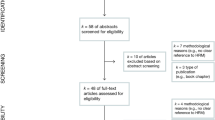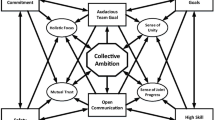Abstract
In this paper, we report from a longitudinal project about knowledge transfer conducted in a major financial company headquartered in Denmark and an offshore development center located in Bangalore, India. We identify the main knowledge transfer challenges experienced by the case company. The challenges inform the conceptual design of a systematic five-step approach to the company’s knowledge transfer. Our main contribution is to illustrate how extant research can be applied to understand and solve the knowledge transfer challenges of a particular company in a way that fits with the outsourcing setup and the company culture. We also draw attention to the fact that client side managers play a crucial role in determining how and with what priority knowledge transfer can take place. Our research indicates that a first, important step towards ensuring successful knowledge transfer in outsourcing is to focus on the training and support of client side managers.
Similar content being viewed by others
Notes
An example of an IT development project that was carried out by a team consisting of both Danish and Indian employees was the re-launch of Danske Bank’s web bank application, while the company’s IT systems for HRM (salary payment, staffing, competence development, etc.) is an example of a application management area that is maintained (i.e. operational problems) and further enhanced (i.e. new functionality) by a team consisting of both Danes and Indians.
References
Beck R., Gregory R., and Prifling M. 2008. “Cultural intelligence and project management interplay in IT offshore outsourcing projects”, Proceedings of the 29th International conference on information systems, Paris, France, 14–17. Dec 2008.
Carmel, E., and Agarwal, R.S. 2001. “Tactical approaches for alleviating distance in global software development”, IEEE Software, March/April, 22–29.
Carmel, E., & Agarwal, R. S. (2002). The maturation of offshore sourcing of information technology work. MIS Quarterly Executive, 1(2), 65–77.
Chen, J., & McQueen, R. J. (2010). Knowledge transfer processes for different experience levels of knowledge recipients at an offshore technical support center. Information Technology and People, 23(1), 54–79.
Cohen, W., & Levinthal, D. (1990). Absorptive capacity: a new perspective on learning and innovation. Administrative Science Quarterly, 35, 128–52.
Dibbern, J., Goles, T., Hirschheim, R., & Jayatilaka, B. (2004). Information systems outsourcing: a survey and analysis of the literature. The Database for Advances in Information Systems, 35(4), 6–102.
Dibbern, J., Winkler, J., & Heinzl, A. (2008). Explaining variations in client extra costs between software projects offshored to India. MIS Quarterly, 32(2), 333–366.
Easterby-Smith, M., Lyles, M. A., & Tsang, E. W. K. (2008). “Inter-organizational knowledge transfer: current themes and future prospects. Journal of Management Studies, 45(4), 677–690.
Gregory, R., Prifling, M., & Beck, R. (2009a). The role of cultural intelligence for the emergence of negotiated culture in IT offshore outsourcing projects. Information Technology and People, 22(3), 223–241.
Gregory, R., Beck R., and Prifling M. 2009b. “Breaching the knowledge transfer blockade in IT offshore outsourcing projects—a case from the financial services industry”, Proceedings of the 42nd Hawaii International Conference on Systems Sciences.
Hertzum, M., & Jørgensen, C. (Eds.). (2011). Balancing sourcing and innovation in information systems development. Trondheim: Tapir Academic Publishers.
Jørgensen, C., Korsaa, M., & Olesen, A. B. (2011). Decision support tool for tactical sourcing. In M. Hertzum & C. Jørgensen (Eds.), Balancing sourcing and innovation in information systems development (pp. 231–252). Trondheim: Tapir Academic Publishers.
Kotlarsky, J., & Oshri, I. (2005). Social ties, knowledge sharing and successful collaboration in globally distributed system development projects. European Journal of Information Systems, 14, 37–48.
Kraut, R. E., Fussel, S. R., Brennan, S. E., & Siegel, J. (2002). Understanding effects of proximity on collaboration: implications for technologies to support remote collaborative work. In P. J. Hinds & S. Kiesler (Eds.), Distributed work (pp. 137–162). Cambridge: MIT Press.
Larsen, K. S., Pries-Heje, J., Scupola, A., & Johansen, J. (2011). Can you outsource innovation? In Jørgensen & Hertzum (Eds.), Balancing sourcing and innovation in information systems development (pp. 23–44). Trondheim: Tapir Academic Publishers.
Madsen, S., Bødker, K., & Tøth, T. (2013). From Research to Practical Application: Knowledge Transfer Planning and Execution in Outsourcing. In Y. K. Dwivedi, H. Z. Henriksen, D. Wastell & R. De (Eds.) Grand successes and failures in IT. Public and Private Sectors (pp. 510–524). Springer Berlin Heidelberg.
Markus, M. L. (2001). Toward a theory of knowledge reuse: types of knowledge reuse situations and factors in reuse success. Journal of Management Information Systems, 18(1), 57–93.
Masino, G., & Zamarian, M. (2003). Information technology artefacts as structuring devices in organizations: design, appropriation and use issues. Interacting with Computers, 15, 693–707.
Mathiassen, L. (2002). Collaborative practice research. Scandinavian Journal of Information Systems, 2002(14), 57–73.
Nonaka,, I. 1991. “The knowledge-creating company”. Harvard Business Review, 96–104.
Nonaka, I. (1994). A dynamic theory of organizational knowledge creation. Organization Science, 5(1), 14–37.
Nonaka, I., and Takeuchi 1995. The Knowledge Creating Company. How Japanese Companies Create the Dynamics of Innovation, Oxford University Press, 1995.
Olson, G., & Olson, J. S. (2000). Distance matters. Human Computer Interaction, 15, 139–178.
Orlikowski, W. J. (1992). The duality of technology: rethinking the concept of technology in organizations. Organization Science, 3(3), 398–427.
Orlikowski, W. J. (2007). Sociomaterial practices: exploring technology at work. Organization Studies, 28(9), 1435–1448.
Oshri, I., Kotlarsky, J., & Willcocks, L. (2008a). Socialization in a global context: lessons from dispersed teams. In N. Panteli & M. Chiasson (Eds.), Exploring virtuality within and beyond organizations: social, global and local dimensions (pp. 21–54). N.Y: Palgrave Macmillan.
Oshri, I., van Fenema, P., & Kotlarsky, J. (2008b). Knowledge transfer in globally distributed teams: the role of transactive memory. Information Systems Journal, 18, 593–616.
Persson, J.S. 2013. “The cross-cultural knowledge sharing challenge: An investigation of the co-location strategy in software development offshoring”, in: Y.K. Dwivedi et al. (Eds.), Proceedings of the IFIP WG 8.6, Bangalore, India, June 27–29, 2013, pp. 310–325.
Pries-Heje, J., & Olsen, L. (2011). Coping with multi-sourcing decisions: a case study from Danske bank. In M. Hertzum & C. Jørgensen (Eds.), Balancing sourcing and innovation in information systems development (pp. 213–230). Trondheim: Tapir Academic Publishers.
Pries-Heje, L., & Pries-Heje, J. (2011). Designing virtual team building with a focus on social capital. In Jørgensen & Hertzum (Eds.), Balancing sourcing and innovation in information systems development (pp. 123–144). Trondheim: Tapir Academic Publishers.
Rollag, K., Parise, S., & Cross, R. (2005). Getting new hires up to speed quickly. MIT Sloan Management Review, 46(2), 35–41.
Sammarra, A., & Biggiero, L. (2008). Heterogeneity and specificity of inter-firm knowledge flows in innovation networks”. Journal of Management Studies, 45, 785–814.
Szulanski, G. (1996). Exploring internal stickiness: impediments to the transfer of best practice within the firm”. Strategic Management Journal, 17, 27–43. special issue.
Van de Ven, A. H. (2007). Engaged schorlarship, a guide for organizational and social research. NY: Oxford University Press.
Vilnai-Yavetz, I., & Rafaeli, A. (2006). Managing artifacts to avoid artifact myopia. In A. Rafaeli & M. G. Pratt (Eds.), Artifacts and organizations, beyond mere symbolism. Mahwah: USA Lawrence Erlbaum Associates.
Acknowledgments
An earlier version of this paper was presented at IFIP WG 8.6 2013, see Madsen et al. (2013). We thank the anonymous reviewers for many constructive comments. The research was supported by a grant from the Danish Ministry for Science, Technology and Development.
Author information
Authors and Affiliations
Corresponding author
Rights and permissions
About this article
Cite this article
Madsen, S., Bødker, K. & Tøth, T. Knowledge transfer planning and execution in offshore outsourcing: An applied approach. Inf Syst Front 17, 67–77 (2015). https://doi.org/10.1007/s10796-014-9516-3
Published:
Issue Date:
DOI: https://doi.org/10.1007/s10796-014-9516-3




